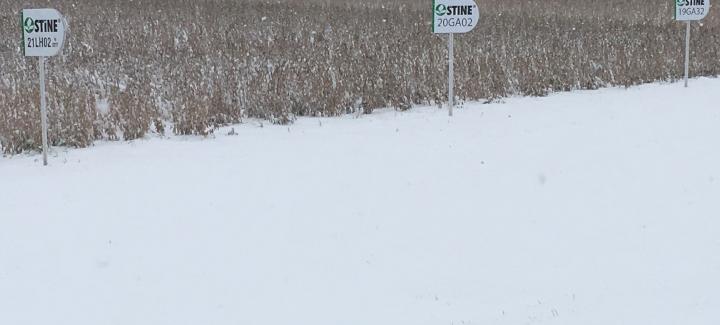
Heavy and frequent rains, early snow accumulation and even a hurricane have delayed harvest for some growers this fall. However, many areas of the United States are still moving along. According to the U.S. Department of Agriculture’s National Agricultural Statistics Service’s Crop Progress Report this week, 39 percent of the corn crop is out versus 27 percent at this time last year. Corn conditions are listed as 21 percent in excellent condition, 47 percent good, 20 percent fair and 12 percent poor to very poor. Soybean harvest is a bit behind schedule compared to last year, with 38 percent harvested as of October 14 compared to 47 percent at this time last year. Soybean conditions are listed as 18 percent excellent, 48 percent good, 23 percent fair and 11 percent poor to very poor. Harvest updates have also been coming in from Stine growers across the country. Here’s what a few of our regional sales agronomists have to report from their regions.
Justin Oden, Region 1 (central Minnesota and west central Wisconsin)
With all the rain and now snow in Region 1, we have very few farmers who have gotten into the fields in Minnesota and Wisconsin. In fact, the image in the header of this article was taken by long-time Stine dealer Dale Evers near Windom, Minnesota. It’s going to be a late harvest for Region 1.
Mike Eckels, Region 8 (north and central Missouri)
Corn is close to 85 percent completed, with yields all over the board. It really depended where growers had rain. Around the Bethany, Missouri, area, it was very dry, so yields were around 30 to 125 bushels per acre. Sedalia area yields improved because they had more rain, ranging from 125 to 200 bushels per acre. St Charles saw 130 to 220 bushels per acre. With a lot of these yield differences being in the same fields, Stine® 9808E-20, 9734-G, 9709G and 9814-10 have all been doing well.
On the soybean side, it is extremely wet across the whole state so about 15 percent of soybeans are harvested. Stine 36LE02, 38LE02, 41LF32 and 42LF02 continue to yield very well for us. The later maturities with the later rains have seen big yield jumps.
Kevin Ryan, Region 14 (Mid-South)
I would estimate that corn and rice harvest are close to 95 percent complete. Cotton is not far behind. There are still quite a few soybeans left in all areas because of rains in the past week. Corn yields have been averaging about 20 bushels per acre below last year’s record yields, more than likely because of delayed planting and high nighttime temperatures this summer. Soybean yields, on the other hand, have been higher than expected.
Bill Kessinger, Region 16 (north central Indiana, southwestern Indiana and northwestern Ohio)
We are wet in Indiana and Ohio. We are behind on harvest, with many farmers about one-third done with corn and one-third done with soybeans. However, yields have been exceptional on both corn and soybeans, so there is a plus side to being behind. The next two weeks look to be below normal temps with only small chances of rainfall for a couple of days. We may have to put on our winter gear, but we’ll hopefully get some harvesting done.
Jason Green, Region 18 (southwestern Indiana, southeastern Illinois and northwestern Kentucky)
Region 18 is a tale of three states. In southeastern Illinois, corn is 75 percent harvested and soybeans are more than 50 percent harvested. In southwestern Indiana, corn is around 25 percent harvested with about 10 percent soybeans harvested. In Kentucky, the western side of the state is almost finished with corn harvest with about 25 percent of soybeans harvested, and the central part of the state is only 30 percent completed with corn and 10 percent on soybeans. Corn yields have been above average, with Stine 9709 and 9814 leading the way. Soybeans are yielding average to slightly above, and excitement is high with the new LibertyLink® GT27™ offering from Stine for 2019.
Stay tuned next week for more harvest updates from Stine regional sales agronomists.
Related Articles
-

Use Stine’s XP® seed treatments to prevent early injury to your crops
December 2025 in Agronomy
-

Understanding Stine’s enhanced oil profile soybeans
December 2025 in Agronomy
-

Soil sampling sets the stage for spring
November 2025 in Agronomy
-

Corn production growth paves way for more high-performing Stine® hybrids
November 2025 in Agronomy



